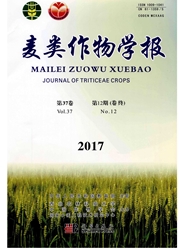

 中文摘要:
中文摘要:
为了更好地利用冠层反射光谱特征监测小麦生长及氮素营养状况。以宁麦9号、淮麦20、徐麦26和扬麦10号四个小麦品种为材料,通过田间小区试验,研究了不同小麦品种在不同生育时期和不同氮素水平下冠层反射光谱的变化规律。结果表明,相同氮素水平下不同小麦品种冠层反射光谱的反射率有差异,且近红外部分差异较明显。小麦从拔节开始,随生育期的推进,冠层反射光谱在可见光波段的反射率先降低然后升高,以孕穗期反射率最低。随着叶片的逐渐变黄。反射率又增大,并且绿光波段的反射峰也逐渐消失。而近红外区反射率则表现出相反的趋势,以开花期为分界,先上升然后下降,直到成熟前降为最低。随着施氮水平的提高,冠层反射光谱在近红外反射平台(750-1300nm)的反射率呈上升趋势,而可见光部分反射率则下降,并且反射光谱的绿峰和红边位置也随着施氮水平的提高分别向蓝光方向(波长变短)和红光方向(波长变长)移动。
 英文摘要:
英文摘要:
The change of canopy spectral reflectance under ditterent cultivars, different growth stages ana varied nitrogen rates were investigated by characterizing canopy multispectral and hyperspectral reflectance in wheat. The results showed that the canopy reflectance differed with cultivars, with significant change at near infrared bands. Reflectance at visible light initially decreased and then increased with growth progress after jointing, with the lowest value appeared at booting. Reflectance increased and reflectance peak also disappeared gradually in course of leaf yellowing. However, reflectance in near infrared had opposite trend, which initially increased and then decreased to the lowest from anthesis to maturity. Reflectance at near infrared reflected flat (750-1300 nm)increased with increasing nitrogen supply, whereas reflectance at visible band decreased, and green peak and red edge position of canopy reflectance spectra also moved to direction of blue light ( short wavelength) and red light (long wavelength), respectively. These results provide background information for monitoring of growth characters and nitrogen status with canopy reflectance spectra in wheat.
 同期刊论文项目
同期刊论文项目
 同项目期刊论文
同项目期刊论文
 期刊信息
期刊信息
